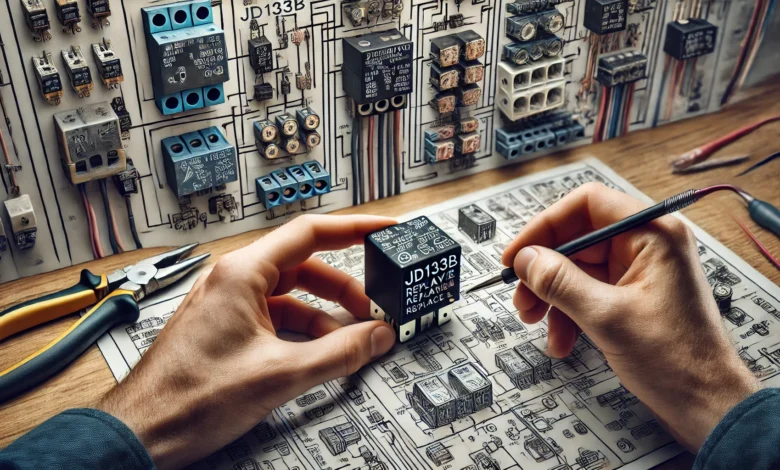JD133B Relay Replacement – Simplify Repairs with Expert Insights

The JD133B relay is a crucial component found in various automotive and industrial systems. Known for its reliability and versatility, this relay ensures the smooth operation of electrical circuits by managing high-current loads with precision. However, like any electronic component, it can fail over time due to wear and tear or external factors. This article provides an in-depth guide to replacing the JD133B relay, helping you simplify repairs with expert insights and actionable steps.
What Is a JD133B Relay?
The JD133B relay is a compact, electromagnetic switch used to control high-current devices. Commonly employed in automotive applications, HVAC systems, and industrial equipment, it acts as a bridge between low-current control circuits and high-power devices such as motors, fans, or lights. The relay’s design ensures minimal energy loss while providing reliable switching capabilities.
Key Features of the JD133B Relay
- High current-handling capacity
- Compact and durable design
- Versatile applications across industries
- Reliable electromagnetic switching mechanism
Common Signs of a Faulty JD133B Relay
Understanding the symptoms of a failing relay can help you diagnose issues quickly. Here are the most common signs:
- Intermittent Operation: Devices controlled by the relay may function sporadically or fail to operate altogether.
- Burnt Smell or Physical Damage: Overheating can cause the relay to emit a burnt smell or show visible signs of damage.
- Clicking Sound Without Activation: A relay that clicks but does not activate the connected device may have internal faults.
- Voltage Drops: Unusual voltage fluctuations in the circuit can indicate relay failure.
If you observe any of these signs, it’s time to replace the JD133B relay.
Tools and Materials Needed for JD133B Relay Replacement
Before starting the replacement process, ensure you have the following tools and materials:
- Replacement JD133B relay
- Screwdrivers (flathead and Phillips)
- Multimeter
- Insulated gloves
- Electrical tape
- Wire cutters/strippers
- Service manual or wiring diagram (specific to your application)
Step-by-Step Guide to Replace the JD133B Relay
Step 1: Safety First
Before working on any electrical system, disconnect the power supply. For automotive applications, disconnect the negative terminal of the car battery. In industrial setups, turn off the main power switch and ensure no current flows through the circuit.
Step 2: Locate the Relay
Refer to the service manual or wiring diagram to find the JD133B relay. In vehicles, it is often located in the fuse box or relay panel under the hood or dashboard. For industrial equipment, it might be inside a control panel.
Step 3: Inspect the Relay and Connections
Visually inspect the relay for signs of damage, such as burnt terminals or discoloration. Check the wiring and connections for fraying, corrosion, or loose terminals.
Step 4: Test the Relay
Use a multimeter to test the functionality of the relay:
- Set the multimeter to continuity mode.
- Check the coil resistance by placing the probes on the coil terminals. Compare the reading to the manufacturer’s specifications.
- Test the switching mechanism by applying a voltage to the coil terminals and checking for continuity across the switch terminals.
If the relay fails any of these tests, it needs replacement.
Step 5: Remove the Faulty Relay
Carefully disconnect the wires or plugs connected to the relay. Use a screwdriver to unmount it if necessary. Note the orientation and terminal configuration to ensure proper installation of the new relay.
Step 6: Install the New Relay
- Align the new JD133B relay with the mounting slot.
- Secure the relay using screws or clips as required.
- Reconnect the wires or plugs, ensuring they match the original configuration.
Step 7: Test the System
Reconnect the power supply and test the system to ensure proper functionality. Observe the operation of the connected devices to confirm the relay is working as intended.
Step 8: Final Checks
Inspect the installation for loose connections or exposed wires. Use electrical tape to secure any vulnerable spots. Reassemble any panels or covers you removed during the process.
Expert Tips for JD133B Relay Replacement
- Choose Quality Replacements: Always use genuine JD133B relays or equivalent replacements to ensure reliability.
- Follow Manufacturer Guidelines: Refer to the service manual for specific installation and testing instructions.
- Regular Maintenance: Periodically inspect relays and other electrical components to prevent unexpected failures.
- Keep Spares Handy: Having a spare JD133B relay can save time and hassle during emergencies.
FAQs About JD133B Relay Replacement
Q1: Can I use a different relay model as a replacement?
Yes, but ensure the replacement relay has the same specifications, such as voltage rating, current capacity, and pin configuration. Using an incompatible relay can damage the circuit.
Q2: How long does a JD133B relay typically last?
The lifespan of a JD133B relay depends on usage and environmental factors. On average, it can last several years under normal operating conditions.
Q3: What causes a JD133B relay to fail?
Common causes include overheating, electrical surges, physical damage, and prolonged use without maintenance.
Q4: Is it safe to replace a relay myself?
Yes, if you follow proper safety precautions and have basic electrical knowledge. For complex systems, consult a professional.
Q5: How do I know if the new relay is working?
Test the system after installation. If the connected devices operate correctly and there are no unusual sounds or voltage drops, the relay is functioning properly.
Conclusion
Replacing a JD133B relay is a straightforward process when you have the right tools, knowledge, and approach. By following this guide, you can simplify the repair and ensure the reliable operation of your electrical systems. Whether you’re working on an automotive, industrial, or household application, these expert insights will help you complete the task efficiently and safely. Regular maintenance and timely replacement of faulty components like the JD133B relay are key to preventing downtime and enhancing system performance.



